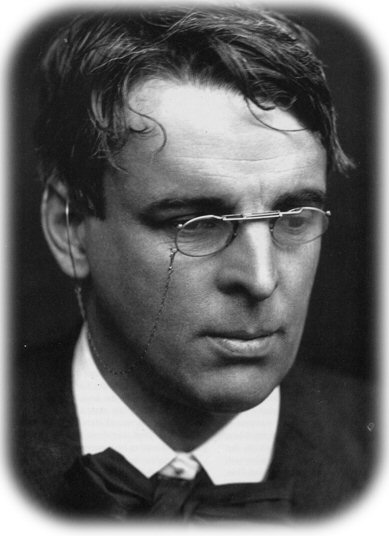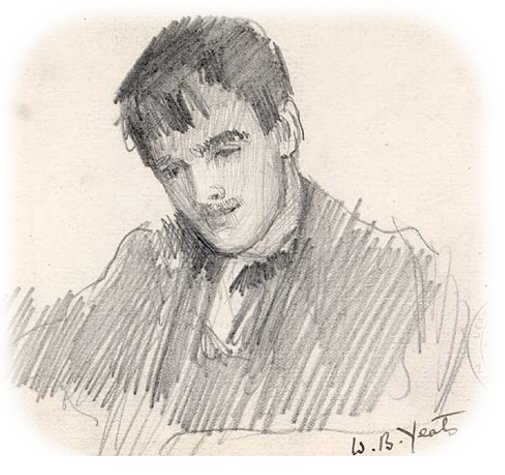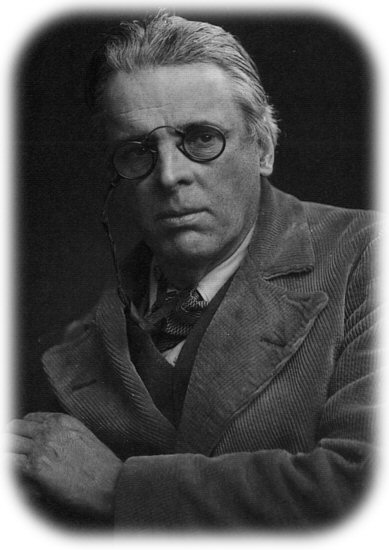 |
Born on
13 June 1865 at 5 Sandymount Avenue, Dublin. Son of John Butler Yeats, barrister
who became a fine (though financially unsuccessful) portrait painter and
Susan Pollexfen, the daughter of a wealthy Sligo merchant family. Shortly
after his birth the family moved to London, where his father thought he
might have more success. |
 |
Went
to the Godolphin School, Hammersmith, but spent delightful holidays in Sligo
with his grandparents. When the family returned to Dublin in 1880 he attended
Erasmus Smith High School, in Harcourt Street, Dublin. His father wished
him to go to Trinity College, following the family tradition, but he refused,
fearing he wouldn't t meet entrance requirements. Instead studied at the
Metropolitan School of Art in 1884–5, then in 1886 at the Royal Hibernian
Academy |
 |
Writer,
dramatist, founder of the Abbey Theatre Greatest modern poet writing in
English.At Metropolitan became friendly with the mystic and poet George
Russell and group of others interested in the occult. At Contemporary Club,
ferment of ideas and lively debate, met Douglas Hyde, Stephen Gwynn, John
O’Leary, Michael Davitt and other important figures. From early age
had been writing poetry and plays in imitation of Shelley and Spenser About
1886 decided to abandon art and devote himself to writing. |
 |
Publishes
first lyrics in the Dublin University Review (1885). Works as literary correspondent
for American newspapers, including Boston Pilot. Interests in Irish myth
and commitment to Irish national identity cause stemmed mainly from living
in West of Ireland and contact with the Fenian, John O’Leary. Joined
Blavatsky London Lodge of Theosophical Society (1887) and Order of the Golden
Dawn (1890). Experiments with occult were as much a matter of poetic imagination
as a pursuit of supernatural. He met most of poets of his generation at
Rhymers’ Club, which he helped found. |
 |
1891 helped
establish Irish Literary Society of London. Following year, in Dublin, joins
John O’Leary in founding National Literary Society to publicise literature,
folklore, and legends of Ireland. 1888 publishes Fairy and folk tales of
the Irish peasantry and his Irish fairy tales appeared in 1892. |
 |
1889
publishes The Wanderings of Oisin, long, highly imaginative poem based on
Irish mythology,1892 The Countess Cathleen, first poetic play. Volume of
folk stories, The Celtic Twilight, appears 1893. 1895 edits A Book of Irish
Verse and publishes Poems. Three collections of poems appear 1897: The Secret
Rose, The Tables of the Law, and The Adoration of the Magi. |
 |
1889
Meets love of life, Maud Gonne, symbolises spirit of tragic beauty &
Irish nationalism. Proposes marriage 1891 but rejected. Impressed by her
revolutionary activities, subject of many of his love poems. Long-sustained
passion had enormous consequences for his politics and poetry. Later wrote
of nationalist politics in his Autobiographies as ‘the fixed ideas
of some hysterical woman, a part of the mind turned into stone’, had
her in mind. Became active in advanced nationalist politics after the Parnellite
split (1890). Tried to mobilise nationalist literary groups as basis for
Irish artistic revival. Joined IRB, played prominent part in the 1798 Rising
centenary celebrations |
 |
1896
met Lady Augusta Gregory,talented and capable woman whose house at Coole
Park, Co Galway, offered warm welcome to writers and artists. She encouraged
him and helped him establish Irish Literary Theatre. George Moore and
Edward Martyn joined him as Irish Literary Theatre Society directors.
Had first, 1899, performance, Yeats’s The Countess Cathleen, great
lot of controversy over it. 1902 Maud Gonne played title role in Yeats’s
Cathleen Ni Houlihan: dramatic triumph. Still deeply in love with her,
but she rejected him again, to his horror married Major John McBride in
1903.
|
 |
Collaborated
with Frank and William Fay led to founding of Irish National Theatre, Yeats
and Lady Gregory co-directors. After 1900 abandons active politics Devotes
life to writing. 1904 Annie Horniman, Manchester wealthy Englishwoman bought
Mechanics’ Institute in Abbey St, Dublin, the Irish Theatre, gave it
a subsidy for some years. On opening night, 27 December 1904, Abbey Players
presented treble bill, On Baile’s Strand and Cathleen Ni Houlihan by
Yeats and Spreading the News by Lady Gregory. It produces new Yeats play
nearly every year. 1906, under new constitution, Yeats, Lady Gregory and
J. M. Synge appointed directors. Yeats remains director until his death.
The founding of the Abbey,in his own words ‘a small dingy and impecunious
theatre’, marks launching of dramatic movement making Dublin important
literary capital in century's 1st quarter. Yeats takes firm stand against
clerics and nationalists, quarrelling over theatre's political and moral
role. |
 |
Yeats
above all, a great poet. An American lecture tour (1903–4) establishes
his reputation. 1913 receives Civil List pension of £150 a year,
but 1915 refuses knighthood Year later proposes again to Maud Gonne, now
a widow since execution of her husband John MacBride, for his part in
the Rising. Refused yet again. Greatest achievement in poetry came with
publication of 4 volumes between 1919-1933. The Wild Swans at Coole (1919),
Michael Robartes and the Dancer (1921), The Tower (1928), and the Winding
Stair (1933). Several poems written in honour of the executed leaders
of 1916 Rising, some of whom had been fellow-workers in literary movement.
|
 |
1917 Yeats
marries Georgie Hyde-Lees (she 26, he 52). Marriage changes life and Georgie
influences his poetry. In A Vision (1925),full of symbolism, sets out his
ideas on mankind and art, the framework of later poems. Two children born,
Anne in 1919, and Michael in 1921. 1922 buys Thoor Ballylee, small derelict
tower-house in Co. Galway, close to Lady Gregory’s home, and 82 Merrion
Square,fine Georgian house in Dublin |
 |
Made
Senator, Irish Free State by President Cosgrave Plays active Senate role.
Chaired committee, design of new coinage. Later made remarkable contribution
to divorce debate, including noble defence of Irish Protestant tradition
with he strongly identified. Received honorary degrees from Queen’s
University College Belfast and University College Dublin. 1923 awardedNobel
Prize for Literature 1932 co-founded with George Bernard Shaw Irish Academy
of Letters, promotion of Irish creative.
|
 |
Mid-twenties,
health began to fail. On medical advice spends winters in Italy and France
from 1927 on. One of last major literary undertakings ; editorship of controversial
Oxford Book of Modern Verse, 1892–1935 (1936). Despite age and ill-health,
output remarkable, especially owerful New Poems (1938) and Last Poems (1938–9).
Late 1938 winter leaves Ireland for Riviera in failing health. Dies at Roquebrune,
Cap Martin, south of France on 28 January 1939. Remains brought back to
Ireland 1948 Re-interred in the churchyard of his grandfather’s parish
at Drumcliff, Co. Sligo. |


